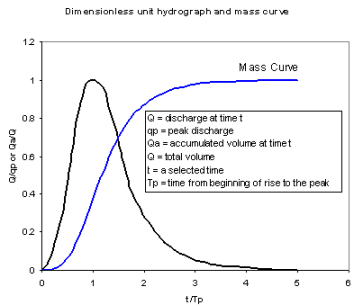SCS Unit Hydrograph Model
The SCS (Soil Conservation Service) unit routing model uses a curvilinear unit hydrograph to calculate runoff resulting from subcatchment net rainfall.
The SCS method uses a dimensionless unit hydrograph derived from the analysis of extensive measured data. For further information, see the FHWA-NHI-02-001 HDS2 Highway Hydrology Technical Report. Table 6.10 from the report listing discharge ratios for selected values of time ratios for the dimensionless unit hydrograph is reproduced as Table 1 below.

Time to peak, Tp and Base Time, Tb are specified in the Subcatchment Grid Window of the Subcatchments Grid or on the Subcatchment Property Sheet. Alternatively, Time of Concn, Tc can be used to compute Tp and Tb.
The method of calculation is selected from the Unit Hydrograph Definition field of the Subcatchment. The available methods are:
- User-Tp-Tb - enter Time to Peak, Tp and Base Time, Tb values for Subcatchment
- SCS-User-Tc - enter Time of Concentration, Tc value for Subcatchment
(Tp and Tb can also be calculated for other Unit Hydrograph Definition options for which Tc is specified. See the Unit Hydrograph Model topic for calculation details.)
Peak discharge, qp is calculated from Tp and unit hydrograph ordinates are determined from the table of ratios for the dimensionless unit hydrograph.
Equations
The equations used by InfoWorks ICM are derived from the documentation of the SCS Unit Hydrograph in the FHWA-NHI-02-001 HDS2 Highway Hydrology Technical Report. See the report for more details and a worked example.
Time to peak and Base time
When using the Unit Hydrograph Definition: SCS-User-Tc, time to peak and base time values are calculated as follows:
|
|
Time to peak, Tp is calculated as:
Base time, Tb, is calculated from Tp:
|
Peak Discharge
Peak discharge qp is calculated as:
|
|
Where: qp is the peak discharge, m3/s (ft3/s) A is the subcatchment area, km2 (mi2) Q is the runoff depth, mm (in) Tp is the time to peak, h Kp is the peaking constant equal to 484, dimensionless a is the unit conversion constant equal to 0.00043 SI units (1 in CU units) |
|
Time Ratios t/Tp |
Discharge Ratios q/qp |
Mass Curve Ratios Qa/Q |
|---|---|---|
|
0 |
0.000 |
0.000 |
|
0.1 |
0.030 |
0.001 |
|
0.2 |
0.100 |
0.006 |
|
0.3 |
0.190 |
0.012 |
|
0.4 |
0.310 |
0.035 |
|
0.5 |
0.470 |
0.065 |
|
0.6 |
0.660 |
0.107 |
|
0.7 |
0.820 |
0.163 |
|
0.8 |
0.930 |
0.228 |
|
0.9 |
0.990 |
0.300 |
|
1.0 |
1.000 |
0.375 |
|
1.1 |
0.990 |
0.450 |
|
1.2 |
0.930 |
0.522 |
|
1.3 |
0.860 |
0.589 |
|
1.4 |
0.780 |
0.650 |
|
1.5 |
0.680 |
0.700 |
|
1.6 |
0.560 |
0.751 |
|
1.7 |
0.460 |
0.790 |
|
1.8 |
0.390 |
0.822 |
|
1.9 |
0.330 |
0.849 |
|
2.0 |
0.280 |
0.871 |
|
2.2 |
0.207 |
0.908 |
|
2.4 |
0.147 |
0.934 |
|
2.6 |
0.107 |
0.953 |
|
2.8 |
0.077 |
0.967 |
|
3.0 |
0.055 |
0.977 |
|
3.2 |
0.040 |
0.984 |
|
3.4 |
0.029 |
0.989 |
|
3.6 |
0.021 |
0.993 |
|
3.8 |
0.015 |
0.995 |
|
4.0 |
0.011 |
0.997 |
|
4.5 |
0.005 |
0.999 |
|
5.0 |
0.000 |
1.000 |



